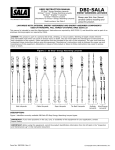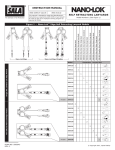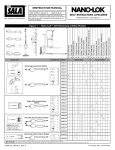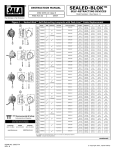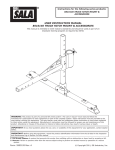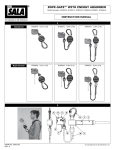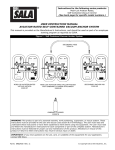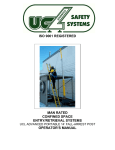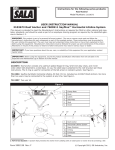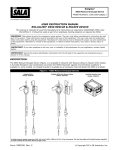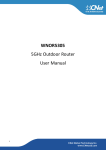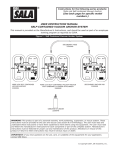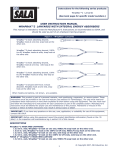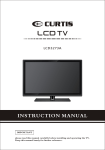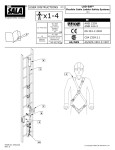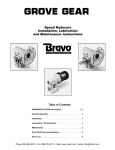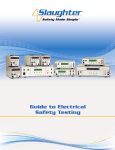Download EZSTOP Instruction Manual
Transcript
DBI-SALA USER INSTRUCTION MANUAL EZ Stop™ Energy Absorbing Lanyards EZ Stop™ Force2™ Energy Absorbing Lanyards EZ Stop™ WrapBax™2 Lanyards EZ Stop™ Modular Lanyards A Capital Safety The Ultimate in Fall Company Protection Model numbers: See Page 13 Energy Absorbing LanyardS Please read this User Manual carefully before installing and using this product. Lanyards With Integral Energy Absorbers and Energy Absorber Components Used in Personal Fall Arrest Systems (ANSI Z359.13) his manual is intended to meet the Manufacturer’s Instructions as required by ANSI Z359.13, and should be T used as part of an employee training program as required by OSHA. Danger: This product is part of a personal fall arrest, climbing, or rescue system. Working at height creates inherent and unavoidable risks which can result in serious injury or death. The user must follow the manufacturer’s instructions for each component of the system. These instructions must be provided to the user of this equipment. The user must read and understand these instructions before using this equipment. Manufacturer’s instructions must be followed for proper use and maintenance of this equipment. Alterations or misuse of this product or failure to follow instructions may result in serious injury or death. Figure 1 - EZ Stop™ Energy Absorbing Lanyards EZ Stop Web Lanyards EZ Stop Cable Lanyards EZ Stop Rope Lanyards EZ Stop Tie-Back Lanyards EZ Stop Modular Lanyards DESCRIPTIONS Figure 1 identifies currently available DBI-Sala EZ Stop Energy Absorbing Lanyard types. IMPORTANT: If you have questions on the use, care, or suitability of this equipment for your application, contact Capital Safety. IMPORTANT: Before using this equipment, record the product identification information from the ID label in the “Inspection and Maintenance Log” in this instruction document. Form No: 5903326 Rev: B © Copyright 2012, DBI Industries, Inc. 1.0APPLICATIONS 1.1PURPOSE: Energy absorbing lanyards are to be used as components in Personal Fall Protection Systems designed to safely arrest a fall. See Figure 1 for the energy absorbing lanyard types covered by this instruction. Energy absorbing lanyards are used in the following applications: Fall Arrest: Fall arrest systems safely stop the user in a free fall from a height. The user can then self-rescue or be rescued. Personal fall arrest systems typically include a full body harness and an energy absorbing lanyard. Maximum arresting force must not exceed 1,800 lbs (8 kN). Restraint: Restraint systems prevent the user from reaching a fall hazard (example: leading edge roof work). Rescue: The energy absorbing lanyard is used as a component of a back-up fall protection system during rescue or as part of the primary rescue system. 1.2 Limitations and Requirements: warning: Always consider the following application limitations and requirements before using this equipment. A. CAPACITY: The EZ Stop Energy Absorbing Lanyard is designed for use by persons with a combined weight (clothing, tools, etc.) of no more than 310 lbs (141 kg)1. The EZ Stop Force2 Energy Absorbing Lanyard can be used for up to a 6 feet (1.8 m) free fall by workers with a combined weight capacity of up to 420 lbs. (190 kg). Make sure all of the components in your system are rated to a capacity appropriate to your application. B. FREE FALL: Personal fall arrest systems incorporating this equipment must be rigged to limit the free fall to 6 feet (1.8 m) or less when using EZ Stop energy absorbing lanyard models, or 12 feet (3.7 m) or less when using EZ Stop Force2 energy absorbing lanyard models. C. FALL CLEARANCE: There must be sufficient clearance below the user to arrest a fall before the user strikes the ground or other obstruction. The clearance required depends on several factors: • • Elevation of anchorage • Energy absorbing lanyard length• Free fall distance Deceleration distance • • Worker height Movement of harness attachment element Figure 2 illustrates fall clearance calculation for an energy absorbing lanyard. D. SWING FALLS: Swing falls occur when the anchorage point is not directly above the point where a fall occurs (see Figure 3). Minimize swing falls by working as close to and directly below the anchorage point as possible. Do not permit a swing fall if injury could occur. Warning: The force of striking an object in a swing fall may cause serious injury or death. E. ENVIRONMENTAL HAZARDS: Use of this equipment in areas with environmental hazards may require additional precautions to prevent injury to the user or damage to the equipment. Hazards may include, but are not limited to; heat, chemicals, corrosive environments, high voltage power lines, gases, moving machinery, and sharp edges. F. Lanyards FOR HIGH TEMPERATURE ENVIRONMENTS: Lanyards with Kevlar webbing are designed for use in high temperature environments, with limitations: Kevlar webbing begins to char at 800° to 900° Fahrenheit. Kevlar webbing can withstand limited contact exposure to temperatures up to 1,000° F. Polyester webbing loses strength at 300° to 400° F. PVC coating on hardware has a melting point of approximately 350° F. G. TRAINING: It is the responsibility of the user and the purchaser of this equipment to assure that they are familiar with these instructions, trained in the correct care and use of, and are aware of the operating characteristics, application limits, and the consequences of improper use of this equipment. 1.3applicable Standards: Refer to national standards including the ANSI Z359 family of standards on fall protection, ANSI A10.32 and applicable local, state, and federal (OSHA) requirements governing occupational safety for more information on Energy Absorbing Lanyards, Energy Absorbers and associated components. 1.4 REscue Plan: When using this equipment, the employer must have a rescue plan and the means at hand to implement the rescue, as well as communicate that plan to users, authorized persons, and rescuers. 1.5Inspection before use: The energy absorbing lanyard must be inspected according to procedures in Section 4 of this instruction manual. 1 Capacity: Most Capital Safety lanyards are factory tested to a maximum capacity of 310 lbs (141 kg). Force 2 Lanyards are factory tested to a maximum capacity of 420 lbs (191 kg). 2 Figure 2 – Fall Clearance Figure 3 – Swing Falls RD = LL + DD + HH + C RD Required Fall Clearance Distance LL Length of Lanyard (Specified on labeling) DD Deceleration Distance = 4 ft (1.2 m) except: LL •for ANSI/OSHA Lanyards with Free Fall greater than 6 ft (1.8 m) up to 12 ft (3.7 m), or user weights greater than 310 lbs (141 kg) up to 420 lbs (191 kg); add 1 ft (0.3 m): DD = 5 ft (1.5 m) Swing Fall Hazard RD DD HH Height of Suspended Worker C Safety Factor = 1.5 ft (0.5 m) (Factors in D-Ring Slide and Harness Stretch.) Example: Assuming a 6 ft (1.8 m) tall user with a typical 6 ft (1.8 m) lanyard with 6 ft (1.8 m) Free Fall, Fall Clearance calculation would be as follows: HH RD = LL + DD + HH + C RD = 6 ft + 4 ft + 6 ft + 1.5 ft = 17.5 ft RD = 1.8 m + 1.2 m + 1.8 m + 0.5 m = 5.3 m C 2.0system requirements 2.1 COMPATIBILITY OF COMPONENTS: Capital Safety equipment is designed for use with Capital Safety approved components and subsystems only. Substitutions or replacements made with non-approved components or subsystems may jeopardize compatibility of equipment and may effect the safety and reliability of the complete system. 2.2 COMPATIBILITY OF CONNECTORS: important: Use only connectors that are suitable to each application and are compatible with connecting elements. • Connectors must be compatible with the anchorage or other system components. • Connectors must be compatible in size, shape, and strength. • Non-compatible connectors may unintentionally disengage (see Figure 4). Connectors are considered to be compatible with connecting elements when they have been designed to work together in such a way that their sizes and shapes do not cause their gate mechanisms to inadvertently open regardless of how they become oriented. Contact Capital Safety if you have any questions about compatibility. Self-locking snap hooks and carabiners are required by ANSI Z359.13 and OSHA. Connectors (hooks, carabiners, and D-Rings) must be capable of supporting at least 5,000 lbs. (22.2 kN). Per ANSI Z359.12, connector gates must be able to withstand a load of 3,600 lbs (16 kN). Figure 4 – Unintentional Disengagement If the connecting element to which a snap hook (shown) or carabiner attaches is undersized or irregular in shape, a situation could occur where the connecting element applies a force to the gate of the snap hook or carabiner. This force may cause the gate (of either a self-locking or a non-locking snap hook) to open, allowing the snap hook or carabiner to disengage from the connecting point. Figure 5 – Inappropriate Connections A. B. C. D. Small ring or other non-compatibly shaped element E. Force is applied to the Snap Hook. The Gate presses against the Connecting Ring. F. G. The Gate opens allowing the Snap Hook to slip off. 2.3Making Connections: Capital Safety connectors (snap hooks and carabiners) are designed to be used only as specified in each product’s user’s instructions. See Figure 5 for inappropriate connections. Capital Safety snap hooks and carabiners should not be connected: A. To a D-Ring to which another connector is attached. B. In a manner that would result in a load on the gate. warning: Large throat snap hooks should not be connected to standard size D-Rings or similar objects which will result in a load on the gate if the hook or D-Ring twists or rotates, unless the snap hook complies with ANSI Z359.12 and is equipped with a 3,600 lb (16 kN) gate. Check the marking on your snap hook to verify that it is appropriate for your application. C. In a false engagement, where features that protrude from the snap hook or carabiner catch on the anchor, and without visual confirmation seems to be fully engaged to the anchor point. D. To each other. 3 E. Directly to webbing or rope lanyard or tie-back (unless the manufacturer’s instructions for both the lanyard and connector specifically allows such a connection). F. To any object which is shaped or dimensioned such that the snap hook or carabiner will not close and lock, or that roll-out could occur. G. In a manner that does not allow the connector to align properly while under load. Caution: Ensure all connectors are fully closed and locked. 2.4 EZ Stop Modular energy absorbing Lanyard models: Refer to Operation and Use, Section 3.3 for instructions on the assembly of the energy absorbing and lanyard components of the EZ Stop Modular Energy Absorbing Lanyard system. 2.5web loop connections: Some lanyards are designed to choke onto a web loop to provide a compatible connection. To choke the lanyard on a web loop: Insert the lanyard web loop through the web loop or D-Ring on the harness. 2.6 Insert the appropriate end of the lanyard through the lanyard web loop. Pull the lanyard through the connecting web loop to secure. ANCHORAGE STRENGTH: Anchorages selected for use with the energy absorbing lanyards must have a strength capable of sustaining the static load requirements of the intended fall protection application: • Fall Arrest: In accordance with ANSI Z359.1, anchorages selected for fall arrest systems shall have a strength capable of sustaining static loads applied in the directions permitted by the system of at least: 1. 5,000 pounds (22.2kN) for non-certified anchorages, or 2. Two times the maximum average arresting force for certified anchorages. hen more than one fall arrest system is attached to an anchorage, the strengths set forth in (1) and (2) above shall W be multiplied by the number of systems attached to the anchorage. WARNING: Anchorages must be rigid. Large deformations of the anchorage will affect system performance, and may increase the required fall clearance below the system, which could result in serious injury or death. From OSHA 1926.500 and 1910.66: Anchorages used for attachment of PFAS shall be independent of any anchorage being used to support or suspend platforms, and capable of supporting at least 5,000 lbs. (22.2 kN) per user attached, or be designed, installed, and used as part of a complete PFAS which maintains a safety factor of at least two, and is supervised by a qualified person. Anchorages selected for work positioning systems shall have a strength capable of sustaining static loads applied in the directions permitted by the system of at least: 3. 3,000 pounds (13.3kN) for non-certified anchorages, or 4. Two times the foreseeable force for certified anchorages. When more than one work positioning system is attached to an anchorage, the strengths set forth in (3) and (4) above shall be multiplied by the number of systems attached to the anchorage. Anchorages selected for fall arrest must sustain loads of 3,372 lbs (15 kN) or greater. • Restraint: Anchorages selected for restraint and travel restraint systems shall have a strength capable of sustaining static loads applied in the directions permitted by the system of at least: 1. 1,000 lbs. (4.5 kN) for non-certified anchorages, or 2. Two times the foreseeable force for certified anchorages. When more than one restraint system is attached to an anchorage, the strength specified above shall be multiplied by the number of systems attached to the anchorage. • Rescue: Anchorages selected for rescue systems shall have a strength capable of sustaining static loads applied in the directions permitted by the system of at least: 1. 3,000 pounds (13.3kN) for non-certified anchorages, or 2. Five times the foreseeable force for certified anchorages. 4 3.0 operation AND USE WARNING: Do not alter or intentionally misuse this equipment. Consult Capital Safety when using this equipment in combination with components or subsystems other than those described in this manual. Some subsystem and component combinations may interfere with the operation of this equipment. Use caution when using this equipment around moving machinery, electrical hazards, chemical hazards, sharp edges, or overhead materials that may fall onto the lanyard. Do not loop the lanyard around small structural members. Failure to heed this warning may result in equipment malfunction, serious injury, or death. WARNING: Consult your doctor if there is reason to doubt your fitness to safely absorb the shock from a fall arrest. Age and fitness seriously affect a worker’s ability to withstand falls. Pregnant women or minors must not use any DBI SALA full body harness. 3.1 BEFORE EACH USE of this equipment, inspect it according to “Inspection Checklist” (Table 1). 3.2PLAN your system before use. Consider all factors that will affect your safety during use of this equipment. The following list gives important points to consider when planning your system: 3.3 • ANCHORAGE: Select an anchorage that meets the requirements specified in “Limitations and Requirements”. • SHARP EDGES: Avoid working where system components may be in contact with, or abrade against, unprotected sharp edges. • AFTER A FALL: Components which have been subjected to the forces of arresting a fall must be removed from service and destroyed. See the “Inspection Checklist” (Table 1). • RESCUE: The employer must have a rescue plan when using this equipment. The employer must have the ability to perform a rescue quickly and safely. EZ Stop Modular energy absorbing Lanyard components assembly: EZ Stop Modular Energy Absorbing Lanyard system components must be properly assembled. The system consists of an energy absorber (A) and a single or twin leg lanyard (B). Figure 6 – Modular EZ Stop Energy Absorbing Lanyard Components A B To assemble EZ Stop modular Lanyard components: Step 1: Step 2: Step 3: Figure 7: Orient the energy absorber female connector and the lanyard male connector as shown. Figure 8: Press the female connector locks (C) on each side of the connector to unlock the device. Insert the male connector and slide to the bottom of the female connector. Release both locks to capture the male connector. The female connector locks must return to their fully extended position. Figure 9: Pull the energy absorber and lanyard in opposite directions to fully seat the male connector. The male connector must be securely locked in the position shown. Figure 7 – Connector Orientation Figure 8 – Press Female Connector Locks, Insert Male Connector Figure 9 – Fully Connected C C Figure 10 – Failed Connection warning: Do not use the modular lanyard assembly if the locks do not return to the fully extended position after following Steps 1, 2 and 3 in Section 3.3. An example of a failed connectiion is shown in Figure 10. The lanyard male connector is not fully inserted and locked within the energy absorber female connector. This is an unsafe condition and the modular lanyard components must not not be used. Refer to Section 4.0 Inspection in this instruction for procedures to determine unsafe or defective component conditions. 5 To disassemble EZ Stop Lanyard modular components: Step 1: Figure 11: Press the female connector locks (C) on each side of the connector to unlock the device. Step 2: Figure 12: While pressing the female connector locks, push the energy absorber and lanyard connectors toward each other. Step 3: Figure 13: Pull the male connector out of the female connector to separate the components. Figure 11 – Press Female Connector Locks Figure 12 – Push Connectors Together Figure 13 – Separate Components C C 3.4 CONNECTING TO body support and ANCHORAGE OR ANCHORAGE CONNECTOR: See Figure 14. Energy absorbing lanyards should be connected to the body support first and then connected to the rest of the system. Always connect the energy absorber end of the lanyard to the D-Ring on the back between the shoulders (dorsal D-Ring) on a full body harness. DBI‑SALA does not recommend using a body belt for fall arrest applications. If using a body belt, connect the energy absorbing end of the lanyard to the D-Ring and position the belt so the D-Ring is located on the back side of the body. Connect the lanyard end to the anchorage or anchorage connector. Some anchorage connector devices may be supplied with a permanently attached energy absorber. Use of an additional energy absorber or energy absorbing lanyard with this lanyard system is not recommended. Figure 14 – Anchorage Connection Examples A Dorsal D-Ring, Full Body Harness B Energy Absorbing Lanyard C Anchorage Connector D Fall Arrestor C B A C C B A D B A 3.5 A. 100% Tie-off Lanyard Considerations: Commonly known as 100% tie-off, “Y” type, twin leg, or double lanyards; these energy absorbing lanyards can be used to provide continuous fall protection while ascending, descending, or moving laterally. With one lanyard leg attached, the worker can move to a new location, attach unused lanyard leg, and disconnect attached leg. This procedure is repeated until a new location is reached. Other practices that must be followed in order to use a 100% tie-off type lanyard safely include: 1. The energy absorber portion of the lanyard must be connected to the dorsal D-Ring only. Use only the snap hook (or other connector provided) to attach the energy absorber portion directly to the harness dorsal D-Ring. See Figures 15 and 16. 2. Do not connect the energy absorber to the anchorage. See Figure 17. Figure 15 – Correct Attachment Figure 16 – Incorrect Attachment Figure 17 – Incorrect Attachment Energy Absorber attached to dorsal D-Ring. Energy Absorber not attached to dorsal D-Ring. 6 Do not attach Energy Absorber to anchor. 3. Do not attach the unused leg of the lanyard back to the harness at any location unless a specially designed lanyard retainer is provided for this purpose. See Figure 18. 4. Connection of both lanyard legs to separate anchorage points is acceptable. See Figure 19. 5. When leapfrogging from one anchorage point to the next (such as traversing a horizontal or vertical structure) do not connect to anchorage points that are further apart than the lanyard length (as marked on the lanyard label). See Figure 20. Figure 18 – Acceptable Designed Retainers Figure 19 – Acceptable Attachment Energy absorber attached to dorsal D-Ring. Lanyard legs conneced to separate anchorage points. Figure 20 – Maximum Lanyard Reach Do not attach to anchorage points wider than lanyard length. 6. Never connect more than one person to a “Y” type lanyard at a time. 7. Do not allow any lanyard to pass under arms or legs during use. Figure 21 – Attaching Tie-Back ttaching a Tie-Back Lanyard: See Figure 21. Place A the tie-back lanyard over the anchoring structure. Ensure the lanyard is not twisted. Adjust the floating D-Ring so it hangs below the anchoring structure. Attach the lanyard end hook to the floating D-Ring. A nsure the lanyard is cinched tight around the anchorage E during use. C B A Do not allow gate to contact anchorage member. B Proper Connection. C Improper connection. Attaching a WrapBax Lanyard: See Figure 22. Snap hooks and WrapBax hooks operate in the same manner. Grip the hook handle in one hand. With your index finger, depress the locking mechanism in. With your thumb, pull back the gate latch. As the gate latch is pulled back, the gate will open. Release your grip and the gate will close. Figure 22 – Snap Hook and WrapBax Hook Operation Pull back gate with thumb Pull back gate with thumb Depress locking mechanism with index finger Depress locking mechanism with index finger Step 1 Step 2 ee Figure 23. Wrap the WrapBax lanyard around an appropriate S anchor (see section 2.6), then open the gate of the WrapBax hook and pass the lanyard through the hook. The lanyard may make more than one wrap around the anchor, but the lanyard may only be passed through the WrapBax hook once. Make sure the lanyard is captured and the gate closes completely. WARNING: Only the WrapBax hook may be used to snap back directly onto the WrapBax lanyard. 7 Step 1 Step 2 Figure 23 – Attaching WrapBax B. CONNECTING TO THE BODY SUPPORT: Connect the energy absorbing lanyard or energy absorber to the D-Ring on the back between the shoulders (dorsal D-Ring) on a full body harness. Connect so the energy absorber portion of the lanyard is on the body support side. DBI‑SALA does not recommend using a body belt for fall arrest applications. If using a body belt, connect the energy absorbing lanyard or energy absorber to the D-Ring and position the belt so the D-Ring is located on the back side of the body. C. Attaching a Lanyard with Web Loops: See Section 2.5. D. CONNECTING TO A ROPE GRAB (FALL ARRESTOR): It is recommended the lanyard end (vs. the energy absorber end) be attached to the rope grab. This recommendation is made to reduce possible interference with the operation of the rope grab by the energy absorber “pack.” Attaching a component style energy absorber to a rope grab is not recommended, with the exception of a “direct-coupling” between a rope grab and a harness. Some rope grabs may be supplied with a permanently attached energy absorbing lanyard. For these cases, use of an additional energy absorber connected between the rope grab and the body support is not recommended. In some cases it may be permissible to couple an energy absorber component between the anchorage (or anchorage connector) and the rope grab lifeline. In all cases, ensure the length of the energy absorber or energy absorbing lanyard does not exceed the rope grab manufacturer’s recommended maximum connection length (3 feet [.9 m] maximum per ANSI Z359.1).Consult the manufacturer’s instructions provided with the Rope Grab for further details. E. 3.6 CONNECTING TO SELF RETRACTING LIFELINE: DBI‑SALA does not recommend connecting an energy absorbing lanyard or energy absorber component to a self retracting lifeline. Special applications do exist where it may be permissible. Contact DBI‑SALA if considering connecting an energy absorbing lanyard to a self retracting lifeline. After use, return the lanyard for cleaning or storage as described in section 5.0. 4.0Inspection 4.1 i-Safe™ rfid Tag: Some lanyards include an i-Safe Radio Frequency Identification (RFID) tag (Figure 24). The RFID tag can be used in conjunction with the i-Safe handheld reading device to simplify inspection and inventory control and provide records for your fall protection equipment. Figure 24 - i-Safe RFID Tag If you are a first-time user, contact a Capital Safety Customer Service representative (see back cover); or if you have already registered, go to isafe.capitalsafety.com. Follow the instructions provided with your i-Safe handheld reader or software to transfer your data to your database. Important: The i-Safe Identification Number on the RFID Tag is for purposes of electronic record keeping with the i-Safe system. Where the Serial Number is printed on the product’s ID Label (see ‘Labeling”), the i-Safe Identification Number and Serial Number may be different numbers. 4.2Inspection Frequency: The Energy Absorbing Lanyard shall be inspected by the user before each use and, additionally, by a competent person2 other than the user at intervals of no more than one year3. Inspection procedures are described in the “Inspection Checklist” (Table 1). Results of each Competent Person inspection should be recorded on copies of the “Inspection and Maintenance Log” (lanyards) or tracked with the i-Safe system. 4.3 Unsafe or Defective conditions: If inspection reveals an unsafe or defective condition, remove the lanyard from service and destroy. Lanyards are not repairable. 4.4 Product Life: The functional life of the lanyard is determined by work conditions and maintenance. As long as the lanyard passes inspection criteria, it may remain in service. WARNING: Failure to properly inspect the lanyard could result in product failure and serious injury or death. Table 1 – Inspection Checklist Component: Inspection: Lanyard Hardware Inspect energy absorbing lanyard or energy absorber component hardware (snap hooks, adjusters, swages, thimbles, etc.). These items must not be damaged, broken, distorted, or have any sharp edges, burrs, cracks, worn parts, or corrosion. Ensure the connecting hooks work properly. Hook gates must move freely and lock upon closing. Ensure adjusters (if present) work properly. Inspect modular lanyard connection components for proper operation. Using the procedures in Section 3.3 of this instruction, confirm that female connector locks move freely when depressed and that they securely capture male connectors when the male and female components are assembled. Modular Lanyard Hardware (See Section 4.2 for Inspection Frequency) Pass Fail 2 Competent Person: One who is capable of identifying existing and predictable hazards in the surroundings or working conditions which are unsanitary, hazardous, or dangerous to employees, and who has authorization to take prompt corrective measures to eliminate them. 3 Inspection Frequency: Extreme working conditions (harsh environments, prolonged use, etc.) may require increasing the frequency of competent person inspections. 8 Table 1 – Inspection Checklist Webbing & Stitching (Diagram 1) The webbing material must be free of frayed, cut, or broken fibers. Check for tears, abrasions, mold, burns, or discoloration, etc. The webbing must be free of knots, excessive soiling, heavy paint buildup, and rust staining. Check for chemical or heat damage indicated by brown, discolored, or brittle areas. Check for ultraviolet damage indicated by discoloration and the presence of splinters or slivers on the webbing surface. All of the above factors are known to reduce webbing strength. Inspect stitching for pulled or cut stitches. Broken stitches may be an indication the energy absorbing lanyard or energy absorber component has been impact loaded and must be removed from service. Wire Rope (Diagram 2) Inspect entire length of the wire rope. Always wear protective gloves when inspecting wire rope. Inspect for broken wires by passing cable through gloved hands, flexing it every few inches to expose breaks. Broken wires can be removed by bending the wire back and forth parallel to the rope length. Do not attempt to pull wires out of rope. Remove the energy absorbing lanyard from service immediately and destroy if there are six or more randomly distributed broken wires in one lay, or three or more broken wires in one strand in one lay. A “lay” of wire rope is the length of wire rope that it takes for a strand (the larger groups of wires) to complete one revolution or twist along the rope. Remove the energy absorbing lanyard from service immediately and destroy if there are any broken wires within 1 inch of the metal compression sleeves (swages) at either end of the assembly. The wire rope should be free of corrosion. Energy Absorber & Impact Indication (Diagram 3) Inspect the energy absorber to determine if it has been activated. There should be no evidence of elongation. Ensure energy absorber cover is secure and not torn or damaged. Labels All labels should be present and fully legible (see Section 7 ‘Labeling’). System & Subsystem Components Inspect each system component or subsystem according to manufacturer’s instructions and confirm that it can continue to be used.. Diagram 1 - Webbing Diagram 2 - Wire Rope Cut Kinked Wire Rope Frayed Broken Wires Heavily Soiled Bird-Caging Welding Burns Welding Splatter Diagram 3 - Impact Indicators The following items indicate the Energy Absorber has been subjected to impact loading and has been activated: 2 1. Torn webbing. 2. Torn or broken cover. 3. Open end or ripped out stitching. 4. Measured length is more than 15 cm (6 in.) longer than the length marked on the label. 3 1 4 5.0MAINTENANCE, SERVICING, STORAGE 5.1 5.2 Clean lanyard with water and a mild detergent solution. Wipe off hardware with a clean, dry cloth, and hang to air dry. Do not force dry with heat. An excessive buildup of dirt, paint, etc., may prevent the lanyard from working properly, and in severe cases degrade the webbing or rope to a point where it has become weakened and should be removed from service. If you have any questions concerning the condition or cleaning of your lanyard, doubts about putting it into service or require more information, contact Capital Safety. Additional maintenance and servicing procedures (replacement parts) must be completed by a factory authorized service center. Authorization must be in writing. Do not disassemble the unit. See Section 4.2 for inspection frequency. 9 5.3 Store the lanyard in a cool, dry, clean environment out of direct sunlight. Avoid areas where chemical vapors may exist. Thoroughly inspect the lanyard or energy absorber component after extended storage. 6.0SPECIFICATIONS Lanyard Model Energy Absorber Specifications EZ Stop Energy Absorber Component 1 1/4 - 1 1/2 in. (3.2 - 3.8 cm) aromatic polyester web strength member, tubular polyester web wear pad (both ends), nylon outer cover, polyester thread, tensile strength greater than 5000 lbs. Fixed Not applicable. Fixed Length EZ Stop Web Leg Lanyards 1 1/4 - 1 1/2 in. (3.2 - 3.8 cm) aromatic polyester web strength member, tubular polyester web wear pad (both ends), nylon outer cover, polyester thread, tensile strength greater than 5000 lbs. Fixed 3/4 - 1 in. (1.9 - 2.5 cm) polyester web, 8,000 - 9,800 lbs. (35.6 - 43.6 kN) tensile strength. Adjustable Length EZ Stop Web Leg Lanyards 1 1/4 - 1 1/2 in. (3.2 - 3.8 cm) aromatic polyester web strength member, tubular polyester web wear pad (both ends), nylon outer cover, polyester thread, tensile strength greater than 5000 lbs. Adjustable 1 in. (2.5 cm) polyester web, 9,800 lbs. (43.6 kN) tensile strength. EZ Stop Cable Leg Lanyards 1 1/4 - 1 1/2 in. (3.2 - 3.8 cm) aromatic polyester web strength member, tubular polyester web wear pad (both ends), nylon outer cover, polyester thread, tensile strength greater than 5000 lbs. Fixed 1/4 in. (.64 cm) diameter steel cable, galvanized, vinyl jacket, 7,000 lbs. (31.1 kN) tensile strength. EZ Stop Rope Leg Lanyards 1 1/4 - 1 1/2 in. (3.2 - 3.8 cm) aromatic polyester web strength member, tubular polyester web wear pad (both ends), nylon outer cover, polyester thread, tensile strength greater than 5000 lbs. Fixed 1/2 in. (1.3 cm) nylon/polyester rope, 10,000 lbs. (44.5 kN) tensile strength. EZ Stop Elastic Leg Lanyards 1 1/4 - 1 1/2 in. (3.2 - 3.8 cm) aromatic polyester web strength member, tubular polyester web wear pad (both ends), nylon outer cover, polyester thread, tensile strength greater than 5000 lbs. Fixed 1 3/8 in. (3.5 cm) tubular polyester web, elastic web, 6,600 lbs. (29.4 kN) tensile strength EZ Stop Resist Web Leg Lanyards 1 1/4 - 1 1/2 in. (3.2 - 3.8 cm) aromatic polyester web strength member, tubular polyester web wear pad (both ends), nylon outer cover, polyester thread, tensile strength greater than 5000 lbs. Fixed 1 in. (2.5 cm) polyester web, polyurethane coated, 9,800 lbs. (43.6 kN) tensile strength. EZ Stop Tie-Back Web Leg Lanyards 1 1/4 - 1 1/2 in. (3.2 - 3.8 cm) aromatic polyester web strength member, tubular polyester web wear pad (both ends), nylon outer cover, polyester thread, tensile strength greater than 5000 lbs. Fixed 1 in. (2.5 cm) polyester web, tubular polyester web cover, 9,800 lbs. (43.6 kN) tensile strength. EZ Stop WrapBax2 Web Leg Lanyards 1 1/4 - 1 1/2 in. (3.2 - 3.8 cm) aromatic polyester web strength member, tubular polyester web wear pad (both ends), nylon outer cover, polyester thread, tensile strength greater than 5000 lbs. Fixed 1 3/6 in. (3.0 cm) nylon web, 13,000 lbs. (57.8 kN) tensile strength EZ Stop Modular Energy Absorber 1 1/4 - 1 1/2 in. (3.2 - 3.8 cm) aromatic polyester web strength member, tubular polyester web wear pad (both ends), nylon outer cover, polyester thread, tensile strength greater than 5000 lbs. Fixed Not applicable. Fixed Specific to lanyard model; see applicable lanyard leg specification. EZ Stop Modular Lanyard Legs 6.1 Adjustable/ Fixed Length Not applicable. Lanyard Specifications Lanyard end Hook Specifications Hook Description Material Gate Strength Throat Size 2000023 Double Action Captive Eye Carabiner Anodized Aluminum Alloy 3,600 lbs (16 kN 0.75 in (1.9 cm) 2000118 Double Action Lock Rebar Snap Hook Zinc Plated Steel 3,600 lbs (16 kN) 2.5 in (6.4 cm) 2000125 Double Action Lock Rebar Snap Hook Zinc Plated Steel 3,600 lbs (16 kN) 3.0 in (7.6 cm) 2000209 Double Action Lock Rebar Snap Hook Anodized Aluminum Alloy 3,600 lbs (16 kN 2.5 in (6.4 cm) 2000210 Double Action Lock Rebar Snap Hook Zinc Plated Steel 3,600 lbs (16 kN 2.5 in (6.4 cm) 2100044 Swiveling Self-Locking Snap Hook with Impact Indicator Stainless Steel 3,600 lbs (16 kN) 0.75 in (1.9 cm) 2109193 Double Action Lock Rebar Snap Hook Zinc Plated Steel 3,600 lbs (16 kN 2.5 in (6.4 cm) 9501804 Double Action WrapBax2 Snap Hook Zinc Plated Steel 3,600 lbs (16 kN 0.82 in (2.1 cm) 9502058 Double Action Lock Rebar Snap Hook Anodized Aluminum Alloy 3,600 lbs (16 kN 2.25 in (5.7 cm) 9502116 Double Action Lock Snap Hook Zinc Plated Steel 3,600 lbs (16 kN 0.75 in (1.9 cm) 9502573 Double Action Lock Snap Hook Zinc Plated Steel 3,600 lbs (16 kN 0.71 in (1.8 cm) 9505254 Double Action Lock Snap Hook Anodized Aluminum Alloy 3,600 lbs (16 kN 0.75 in (1.9 cm) important: All systems, sub-systems and components marked with ANSI have been tested and qualified/verfied in an ISO 17025 accredited lab per ANSI Z359.7. 10 7.0 LABELING All EZ Stop Lanyard models: Warning, Use, Identification and Inspection labels are located on and inside a protective cover on the back side of the lanyard energy absorber. Pull Tab to open the cover and expose the labels. A or B C Tab Tab D E A: Warning/Use, ANSI models, EZ Stop B: Warning/Use, ANSI models, EZ Stop Force2 C: Warning/Inspection, on protective cover D: Warning, on protective cover tab E: iSafe RFID Tag, attached to protective cover; also on some lanyard legs. Warning/Use, ANSI models, EZ Stop Modular Lanyard Leg Component 11 Individual labels, identified by model Type: Inspection Log Label, all models Front iSafe Label, all models Back Warning/Use, Twin Leg models Front Warning/Use, WrapBax models Back Warning/Use, WrapBax models Front Warning/Use, Tie-Back models Back Warning/Use, Connecting Loop models 12 EZ Stop Lanyards in this instruction The following models are covered by this instruction: Models - ANSI, Web Models - ANSI, rope 1246010 1246088 1246145 1246180 1246230 1246270 1246275 1246280 1246287 1246011 1246089 1246147 1246192 1246232 1246271 1246276 1246281 1246290 1246012 1246090 1246148 1246193 1246233 1246272 1246277 1246284 1246291 1246013 1246091 1246149 1246196 1246234 1246273 1246278 1246285 1246294 1246274 1246279 1246286 1246295 1246014 1246093 1246150 1246197 1246235 1246015 1246094 1246151 1246198 1246236 1246016 1246098 1246152 1246199 1246239 Models - ANSI, CAble: 1246017 1246099 1246153 1246200 1246240 1246135 1246183 1246187 1246018 1246100 1246155 1246201 1246241 1246136 1246184 1246188 1246019 1246101 1246156 1246202 1246242 1246181 1246185 1246189 1246021 1246102 1246157 1246203 1246242 1246182 1246186 1246190 1246244 1246022 1246103 1246158 1246204 1246243 1246023 1246104 1246159 1246205 1246245 1246024 1246107 1246160 1246206 1246246 1246040 1246044 1246048 1246060 1246025 1246110 1246161 1246207 1246247 1246041 1246045 1246049 1246061 Models - ANSI, Modular: 1246026 1246112 1246162 1246208 1246248 1246042 1246046 1246050 1246064 1246027 1246113 1246163 1246212 1246249 1246043 1246047 1246051 1246065 1246028 1246116 1246164 1246213 1246245 1246029 1246120 1246165 1246214 1246246 1246070 1246121 1246166 1246215 1246247 1246071 1246122 1246167 1246216 1246248 1246072 1246123 1246168 1246217 1246249 1246073 1246124 1246169 1246218 1246250 1246074 1246125 1246170 1246222 1246251 1246075 1246130 1246171 1246223 1246252 1246080 1246140 1246172 1246225 1246255 1246081 1246141 1246173 1246226 1246255 1246085 1246142 1246174 1246227 5002045 1246086 1246143 1246176 1246228 1246087 1246144 1246177 1246229 13 INSPECTION AND MAINTENANCE LOG SERIAL NUMBER: MODEL NUMBER: DATE PURCHASED: INSPECTION DATE Approved By: Approved By: Approved By: Approved By: Approved By: Approved By: Approved By: Approved By: Approved By: Approved By: Approved By: Approved By: Approved By: Approved By: Approved By: Approved By: Approved By: Approved By: DATE OF FIRST USE: INSPECTION ITEMS NOTED CORRECTIVE ACTION MAINTENANCE PERFORMED INSPECTION AND MAINTENANCE LOG SERIAL NUMBER: MODEL NUMBER: DATE PURCHASED: INSPECTION DATE Approved By: Approved By: Approved By: Approved By: Approved By: Approved By: Approved By: Approved By: Approved By: Approved By: Approved By: Approved By: Approved By: Approved By: Approved By: Approved By: Approved By: Approved By: DATE OF FIRST USE: INSPECTION ITEMS NOTED CORRECTIVE ACTION MAINTENANCE PERFORMED LIMITED LIFETIME WARRANTY Warranty to End User: D B Industries, Inc., dba CAPITAL SAFETY USA (“CAPITAL SAFETY”) warrants to the original end user (“End User”) that its products are free from defects in materials and workmanship under normal use and service. This warranty extends for the lifetime of the product from the date the product is purchased by the End User, in new and unused condition, from a CAPITAL SAFETY authorized distributor. CAPITAL SAFETY’S entire liability to End User and End User’s exclusive remedy under this warranty is limited to the repair or replacement in kind of any defective product within its lifetime (as CAPITAL SAFETY in its sole discretion determines and deems appropriate). No oral or written information or advice given by CAPITAL SAFETY, its distributors, directors, officers, agents or employees shall create any different or additional warranties or in any way increase the scope of this warranty. CAPITAL SAFETY will not accept liability for defects that are the result of product abuse, misuse, alteration or modification, or for defects that are due to a failure to install, maintain, or use the product in accordance with the manufacturer’s instructions. CAPITAL SAFETY’S WARRANTY APPLIES ONLY TO THE END USER. THIS WARRANTY IS THE ONLY WARRANTY APPLICABLE TO OUR PRODUCTS AND IS IN LIEU OF ALL OTHER WARRANTIES AND LIABILITIES, EXPRESSED OR IMPLIED. CAPITAL SAFETY EXPRESSLY EXCLUDES AND DISCLAIMS ANY IMPLIED WARRANTIES OF MERCHANTABILITY OR FITNESS FOR A PARTICULAR PURPOSE, AND SHALL NOT BE LIABLE FOR INCIDENTAL, PUNITIVE OR CONSEQUENTIAL DAMAGES OF ANY NATURE, INCLUDING WITHOUT LIMITATION, LOST PROFITS, REVENUES, OR PRODUCTIVITY, OR FOR BODILY INJURY OR DEATH OR LOSS OR DAMAGE TO PROPERTY, UNDER ANY THEORY OF LIABILITY, INCLUDING WITHOUT LIMITATION, CONTRACT, WARRANTY, STRICT LIABILITY, TORT (INCLUDING NEGLIGENCE) OR OTHER LEGAL OR EQUITABLE THEORY. TheUltimate Ultimate in in Fall The Fall Protection Protection CSG USA & Latin America 3833 SALA Way Red Wing, MN 55066-5005 Toll Free: 800.328.6146 Phone: 651.388.8282 Fax: 651.388.5065 [email protected] CSG Canada 260 Export Boulevard Mississauga, ON L5S 1Y9 Phone: 905.795.9333 Toll-Free: 800.387.7484 Fax: 888.387.7484 [email protected] CSG Northern Europe 5a Merse Road North Moons, Moat Reditch, Worcestershire, UK B98 9HL Phone: + 44 (0)1527 548 000 Fax: + 44 (0)1527 591 000 [email protected] CSG EMEA (Europe, Middle East, Africa) Le Broc Center Z.I. 1ère Avenue 5600 M B.P. 15 06511 Carros Le Broc Cedex France Phone: + 33 4 97 10 00 10 Fax: + 33 4 93 08 79 70 [email protected] CSG Australia & New Zealand 95 Derby Street Silverwater Sydney NSW 2128 AUSTRALIA Phone: +(61) 2 8753 7600 Toll-Free : 1 800 245 002 (AUS) Toll-Free : 0800 212 505 (NZ) Fax: +(61) 2 87853 7603 [email protected] CSG Asia Singapore: 16S, Enterprise Road Singapore 627666 Phone: +65 - 65587758 Fax: +65 - 65587058 [email protected] www.capitalsafety.com I S O 9001 Certificate No. FM 39709 Shanghai: Rm 1406, China Venturetech Plaza 819 Nan Jing Xi Rd, Shanghai 200041, P R China Phone: +86 21 62539050 Fax: +86 21 62539060
















